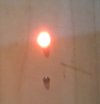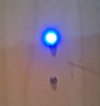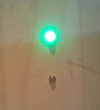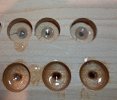I'm making my daughter a Christmas present that requires the light of 110 LEDs to be brought from pockets in the back of the facepiece to the front. The holes for the light are 1/8" diameter.
I looked at acrylic rods inserted into the holes and various materials that could be injected, including silicones, acrylates, pourable epoxy, etc.
After about 60 tests, I settled on hot glue made by Adhesive Technologies. It is colorless and has a refractive index of about 1.48 which closely matches the epoxy used on the LEDs. This reduces internal reflection and offers better light transmission. It's available on amazon. The pourable epoxy would be a good material choice, but its low viscosity makes it a challenge to contain in this project. Also the other materials offered an advantage of over injecting (from the back) by about 1/8" to form a small dome. This gives a wider field of view for the light. The other advantage is it cools in a few minutes and is ready to go.
The LEDs emit at about 160 degrees, so I included a chamfer at the inlet to help capture more light. Shown in the rear picture. The top row is the glue.
Maybe this will come in handy for someone else.
I looked at acrylic rods inserted into the holes and various materials that could be injected, including silicones, acrylates, pourable epoxy, etc.
After about 60 tests, I settled on hot glue made by Adhesive Technologies. It is colorless and has a refractive index of about 1.48 which closely matches the epoxy used on the LEDs. This reduces internal reflection and offers better light transmission. It's available on amazon. The pourable epoxy would be a good material choice, but its low viscosity makes it a challenge to contain in this project. Also the other materials offered an advantage of over injecting (from the back) by about 1/8" to form a small dome. This gives a wider field of view for the light. The other advantage is it cools in a few minutes and is ready to go.
The LEDs emit at about 160 degrees, so I included a chamfer at the inlet to help capture more light. Shown in the rear picture. The top row is the glue.
Maybe this will come in handy for someone else.




